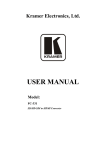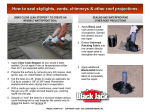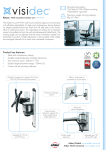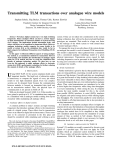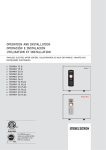Download HighLow count system
Transcript
06/16/04 Blackjack Counter database High-Low Count System DeepNet Technologies Web: www.deepnettech.com E-mail: [email protected] Thank you for purchasing this supplementary database for Blackjack Counter. This set is based on index tables defined in "Professional Blackjack" by Stanford Wong (see the section "Selected Bibliography" at the end of this document). It is commonly known as the High-Low count system. A number of different index sets are included for different rule variants. The index sets correspond exactly to a particular Action table. Note: it is very important to select a matching set of rules, Action table, and Index set. The index sets in this database are named to correspond to particular action tables. The full set of Basic Strategy tables is included in this database as well to make sure that you have matching data. Each index set is described below, telling you exactly how to match it up with the casino rules. NOTE: if the product you purchased includes the High-Low database, then the High-Low database is already installed automatically for you. The only exception is if the installation program determined you have an existing install, and you explicitly indicated not to overwrite the existing software (this is not the default, so this would only be true if you explicitly switched the setting). Installation for Palm OS To install this database in Blackjack Counter for Palm OS, do the following: • Make sure version 3.0 or higher of Blackjack Counter is installed and registered on your Palm device. Select 'About' from the Help menu to check the version number. You can get the latest version from our web site: http://www.deepnettech.com/bjcounter.zip. To install the newer version, simply install the 'bjcounter.prc' program in the downloaded zip file to your Palm device. Do not uninstall your prior version of Blackjack Counter. If you do, you will lose any custom databases you have created, and will have to re-enter your registration code. Make sure you run Blackjack Counter at least once before installing this supplementary database. • Extract the pdb file(s) from the zip file that was e-mailed to you after you purchased the database (HighLow.zip). Copyright 2000-2001, DeepNet Technologies DeepNet Technologies 06/16/04 • Install these pdb files to your Palm device, as you would any other program (see the User Manual that came with your Palm device if your are unsure how to do this). If your desktop operating system is Windows, all you have to do is double click on the pdb file from Explorer. • Run Blackjack Counter on your Palm device. You will see this screen: • Tap on the 'Yes' button. The extra action tables, count systems, and/or index sets in this database will be installed in Blackjack Counter. This dialog will not come up again after the database is installed. If you tap 'No', the database is not installed and you will be prompted again the next time you run Blackjack Counter. If you tap 'No, delete all', the database is not installed and is deleted (you will not be prompted the next time you run Blackjack Counter. • Note: Databases can only be installed if Blackjack Counter is registered. • This database includes all of the default tables that come with Blackjack Counter initially. They are included in this database since there have been a number of small corrections made over time. Copyright 2000-2001, DeepNet Technologies Page 2 of 13 DeepNet Technologies 06/16/04 • Although you have several choices, you should use 'Replace the original' option and tap on the 'Same for rest' button. This will update your default systems and ensure that your tables are correct. • Switch to Action mode, and tap on the 'Table' button. • Make sure the 'Use action table' checkbox is set. • Select the action table you want to use. The heading describe the different tables. • Note: do not install more than one supplementary database in Blackjack Counter at a time. Sync one database, run Blackjack Counter to incorporate the database, then install the next database. Installation for Windows To install this database in Blackjack Counter for Windows, do the following: • Extract the pdb file(s) from the zip file that was e-mailed to you after you purchased the database ((HighLow.zip). • Start Blackjack Counter for Windows. Select 'Open settings/systems…' from the file menu. Switch the 'Files of type' option in the file browser to 'BJ Counter file (Palm, *.pdb)'. Select the pdb file you downloaded and saved in the prior step. • Click 'OK' to the next dialog to input the new systems. • This database includes all of the default tables that come with Blackjack Counter initially. They are included in this database since there have been a number of small corrections made over time. Copyright 2000-2001, DeepNet Technologies Page 3 of 13 DeepNet Technologies • 06/16/04 If you have any action tables, count systems, or index sets with the same names, you will be prompted about replacement. Switch the selection to the second replacement choice as shown below, and click on the 'Same for rest' button. Installation for Pocket PC To install this database in Blackjack Counter for Pocket PC, do the following: • Extract the pdb file(s) from the zip file that was e-mailed to you after you purchased the database (HighLow.zip). • Put your Pocket PC device in the cradle and turn it on. • Start the 'Microsoft ActiveSync' program from the Start/Programs menu on your Windows desktop. • Click on the 'Explore' toolbar button in ActiveSync. Copy the pdb files extracted earlier to the device directory window just opened (the root 'My Documents' folder is the initial directory that is opened). • Start Blackjack Counter for Pocket PC. Select 'Open settings/systems…' from the file menu. Make sure the 'Type' option in the file browser is set to 'BJ Counter file (Palm, *.pdb)'. Select the pdb file you downloaded and saved in the prior step. • Click 'OK' to the next dialog to input the new systems. • This database includes all of the default tables that come with Blackjack Counter initially. They are included in this database since there have been a number of small corrections made over time. • If you have any action tables, count systems, or index sets with the same names, you will be prompted about replacement. Switch the selection to the second replacement choice as shown below, and click on the 'Same for rest' button. Copyright 2000-2001, DeepNet Technologies Page 4 of 13 DeepNet Technologies 06/16/04 Selecting the High-Low Count System Make sure you select this system in Count mode: • • • • • • • • • • Switch to Count mode. Tap on the 'Options' button. Select the 'High-Low' count system. Switch to 'Action mode'. Tap on the 'Table' button. Make sure 'Use action table' is selected. Select the correct action table for your casino rules. Switch to Index mode. Tap on the 'Set' button. Select the Index set that has the matching name to the Action table you are using. For example, if you are using the 'Single2: DAS, S17, DblAny' table, select the 'HighLow: Single2' Index set. Note: it is very important to select a matching index set, or the index values will not correspond to the right plays. The High-Low System The High-Low system is one of the most common and widely used Blackjack count systems available. It is a very good entry-level true-count system that uses one-level card values. For details on the specific parameters of the system, tap the 'Edit system' button in the Options dialog available from Count mode in Blackjack Counter. The system was originally designed by Stanford Wong and published in his book "Professional Blackjack". Copyright 2000-2001, DeepNet Technologies Page 5 of 13 DeepNet Technologies 06/16/04 The betting range for this system depends on the number of decks. For eight decks, the bet range is 1 to 10 betting units. For single deck, the range is 1 to 3. Tap on the 'Deck data' button in the Edit systems dialog for further details. Stanford Wong uses a 1 to 10 bet range in his eight-deck benchmark game in "Professional Blackjack". That spread has been simplified slightly in the deck data entered into this High-Low system. Although his book does not specify betting spreads for single deck, a range of 1 to 3 has been used since 1 to 10 will attract undue attention in the casino, likely resulting in barring! High-Low: Multi1 This index set corresponds to: • • • • • • Count system: High-Low Action table: Multi1: D8, noDAS, h17, DblAny 4 or more decks. No double after splits (noDAS). Dealer hits on soft 17 (H17). Player may double any first two dealt cards (DblAny). You will find that this table more closely matches Wong's slightly reduced table in the main part of his book, rather than the 4-deck full index published in his appendix. The differences are very minor. This is true of all the multi-deck index sets below. High-Low: Multi2 This index set corresponds to: • • • • • • Count system: High-Low Action table: Multi2: D8, DAS, h17, DblAny 4 or more decks. Double after splits (DAS). Dealer hits on soft 17 (H17). Player may double any first two dealt cards (DblAny). High-Low: Multi3 This index set corresponds to: • • • • • • Count system: High-Low Action table: Multi3: D8, DAS, s17, DblAny 4 or more decks. Double after splits (DAS). Dealer stands on soft 17 (S17). Player may double any first two dealt cards (DblAny). High-Low: Multi4 This index set corresponds to: Copyright 2000-2001, DeepNet Technologies Page 6 of 13 DeepNet Technologies • • • • • • 06/16/04 Count system: High-Low Action table: Multi4: D8, noDAS, s17, DblAny 4 or more decks. No double after splits (noDAS). Dealer stands on soft 17 (S17). Player may double any first two dealt cards (DblAny). High-Low: Single1 This index set corresponds to: • • • • • • Count system: High-Low Action table: Single1: D1, noDAS, s17, DblAny 1 deck. No double after splits allowed (noDAS). Dealer stands on soft 17 (s17). Player may double any first two dealt cards (DblAny). These single deck index tables are based on the charts published in the Appendix of Wong's book. Wong publishes the following unusual index for this table: "66/7 c<0:Split". Since this index is highly questionable, and has no equivalent in other related count systems, it has been excluded from this index set. You may add it back in if you wish. The 44 row is taken from the two-card double A3 table in Wong's book. Note the unusual positive indices for 44/5 and 44/6. Although these may appear unusual, they are correct in respect to Basic Strategy in that the count will be 3 higher anyway (resulting in BS play of double when the starting round count is zero). The 77 row is partially taken from the two-card hit/stand table in Wong's book, as well as the noDAS split table. High-Low: Single2 This index set corresponds to: • • • • • • Count system: High-Low Action table: Single2: D1, DAS, s17, DblAny 1 deck. Double after splits allowed (DAS). Dealer stands on soft 17 (s17). Player may double any first two dealt cards (DblAny). The 44/7 index is taken from the two-card double A3 table in Wong's book. Note the unusual positive index for 44/4. Although this may appear unusual, it is correct in respect to Basic Strategy in that the count will be 3 higher anyway (resulting in BS play of double when the starting round count is zero). Copyright 2000-2001, DeepNet Technologies Page 7 of 13 DeepNet Technologies 06/16/04 The 77 row is partially taken from the two-card hit/stand table in Wong's book, as well as the DAS split table. Wong publishes the following unusual index for this table: "33/8 c>=0:Split". Since this index is highly questionable, and has no equivalent in other related count systems, it has been excluded from this index set. You may add it back in if you wish. High-Low: Single3 This index set corresponds to: • • • • • • Count system: High-Low Action table: Single2: D1, noDAS, h17, Dbl10-11 1 deck. No double after splits allowed (DAS). Dealer hits soft 17 (h17). Player may double only on a first two card count of 10 or 11. This index is the same as Single4, with all invalid double indices removed. High-Low: Single4 This index set corresponds to: • • • • • • Count system: High-Low Action table: Single2: D1, noDAS, h17, DblAny 1 deck. No double after splits allowed (DAS). Dealer hits soft 17 (h17). Player may double any first two dealt cards (DblAny). The 77 row is partially taken from the two-card hit/stand table in Wong's book, as well as the noDAS split table. Wong publishes the following unusual index for this table: "66/7 c<0:Split". Since this index is highly questionable, and has no equivalent in other related count systems, it has been excluded from this index set. You may add it back in if you wish. The 44 row is taken from the two-card double A3 table in Wong's book. Note the unusual positive indices for 44/5 and 44/6. Although these may appear unusual, they are correct in respect to Basic Strategy in that the count will be 3 higher anyway (resulting in BS play of double when the starting round count is zero). High-Low: Single5 This index set corresponds to: • • • Count system: High-Low Action table: Single2: D1, DAS, h17, DblAny 1 deck. Copyright 2000-2001, DeepNet Technologies Page 8 of 13 DeepNet Technologies • • • 06/16/04 Double after splits allowed (DAS). Dealer does not hit soft 17 (s17). Player may double any first two dealt cards (DblAny). The 77 row is partially taken from the two-card hit/stand table in Wong's book, as well as the DAS split table. The 44/7 index is taken from the two-card double A3 table in Wong's book. Note the unusual positive index for 44/4. Although this may appear unusual, it is correct in respect to Basic Strategy in that the count will be 3 higher anyway (resulting in BS play of double when the starting round count is zero). Wong publishes the following unusual index for this table: "33/8 c>=0:Split". Since this index is highly questionable, and has no equivalent in other related count systems, it has been excluded from this index set. You may add it back in if you wish. High-Low: Fab18 There are four index sets that corresponds to Donald Schelesinger's "Fabulous 18" indices. This is a very good reduced set of indices that can deliver up to 90% of the expectation (depending on the rules). You should pick the right index set for the rules you are using. Note that DAS/noDAS does not affect the index set, since no soft hand indices are included. This reduced index set is much easier to learn, and delivers most of the expectaton you can receive. In multi-deck games, the "Fabulous 18" delivers 95% of the expectation! High-Low: Surrender index sets Secondary index sets are included in this database to properly support Surrender. The secondary index feature was added in Blackjack Counter version 3.0, and Blackjack Expert version 2.0. Use the secondary surrender index that matches your options (for example, with the 'High-Low:Multi3' action table use the 'High-Low: Multi3/4, Sur. S17' index set). If surrender is available to you, configure Blackjack Counter as follows: • • • • • • Enable the 'Allow surrender' option in the Preferences dialog (Command menu). Go to Index mode. Make sure 'Use indices in Drill mode' is turned on. Select a matching main index. Tap on 'Second index'. Select the matching secondary index set. In Blackjack Expert, make sure the 'Allow late surrender' Casino option is set. Simulation Results This table provides detailed performance data for each of the index sets in this database. This data was derived using Blackjack Audit, a new simulation analysis program by DeepNet Technologies. A description of the columns is provided after the table. A minimum of one billion rounds were run to compute these values. Copyright 2000-2001, DeepNet Technologies Page 9 of 13 DeepNet Technologies 06/16/04 Note that the single deck expectations may be lower than you expected. This is most likely due to the lower betting range (1 to 3) that has been used in these simulations. With a betting range of 1 to 5, the expectation does improve. Of course, finding a casino that let's you range your bets that much in single deck is challenging! High-Low System Performance Index set DAS/ H17/ Dbl. # decks noDAS S17 Bet Pen. Exp. range Exp. (Sur.) Multi1 8 NoDAS H17 Any 1-10 3/4 .22% .39% Multi2 8 DAS H17 Any 1-10 3/4 .35% .52% Multi3 8 DAS S17 Any 1-10 3/4 .51% .67% Multi4 8 noDAS S17 Any 1-10 3/4 .39% .55% Single1 1 NoDAS S17 Any 1-3 2/3 1.09% 1.26% Single2 1 DAS S17 Any 1-3 2/3 1.21% 1.38% Single3 1 NoDAS H17 10-11 1-3 2/3 .64% .95% Single4 1 NoDAS H17 Any 1-3 2/3 .95% 1.10% Single5 1 DAS H17 Any 1-3 2/3 1.07% 1.22% Fab18, Multi, h17 8 DAS H17 Any 1-10 3/4 0.32% N/A Fab18, Multi, s17 8 DAS S17 Any 1-10 3/4 0.50% N/A Fab18, Single, h17 1 NoDAS H17 Any 1-3 2/3 0.82% N/A Fab18, Single, s17 1 NoDAS S17 Any 1-3 2/3 0.93% N/A Index set: the High-Low index set used in the simulation # decks: the number of decks in the simulation. DAS/noDAS: whether double after splitting was allowed in the simulation. H17/S17: Whether the dealer hit soft seventeen in the simulation. Dbl.: Doubling restrictions, if any. Bet range: the unit bet range applied in the simulation. This depends on the number of decks only, and is defined in the count system 'Deck data'. Pen.: the shoe penetration used in the simulation. 3/4 is used for multi-deck, 2/3 is used for single deck. Exp.: the expectation for the simulation (amount won or lost divided by the total amount bet). Although there are other statistics that are important to consider, the expectation is a good indicator about the return rate of a system (higher is better, negative means you will lose money in the long run). Copyright 2000-2001, DeepNet Technologies Page 10 of 13 DeepNet Technologies 06/16/04 Exp. (Sur.): the expectation for the simulation if late surrender is available. Note that the bankroll calculations are computed without surrender. Bankroll requirements will be slightly lower with late surrender, both because of the greater expectation and a nominal decrease in variance (effectively reduces a small number of large bets). Report files are You will find corresponding report files (i.e. HighLow_multi3.txt) in the zip file for this database for each of the rows in the above table. Additional performance data is available in these report files, generated using Blackjack Audit. High-Low System Bankroll/ROR The values from this table were also generated using Blackjack Audit. The ROR calculator was used for the lifetime ROR column, and the ROR simulator was used for the trip columns. Index set DAS/ H17/ Dbl. # decks noDAS S17 Bet Lifetime range bankroll Trip Trip ROR bankroll Multi1 8 NoDAS H17 Any 1-10 $17736 $1125 4.98% Multi2 8 DAS H17 Any 1-10 $11206 $1125 4.95% Multi3 8 DAS S17 Any 1-10 $7620 $1105 4.84% Multi4 8 noDAS S17 Any 1-10 $9867 $1105 4.85% Single1 1 NoDAS S17 Any 1-3 $1848 $715 4.65% Single2 1 DAS S17 Any 1-3 $1694 $710 4.70% Single3 1 NoDAS H17 10-11 1-3 $3020 $730 4.73% Single4 1 NoDAS H17 Any 1-3 $2139 $730 4.71% Single5 1 DAS H17 Any 1-3 $1925 $725 4.81% Fab18, Multi, h17 8 DAS H17 Any 1-10 $11892 $1115 4.93% Fab18, Multi, s17 8 DAS S17 Any 1-10 $7751 $1095 4.89% Fab18, Single, h17 1 NoDAS H17 Any 1-3 $2426 $735 4.87% Fab18, Single, s17 1 NoDAS S17 Any 1-3 $2110 $715 4.77% Lifetime bankroll: The amount of bankroll you should start with to ensure a 5% lifetime risk of ruin (ROR), using a $5 betting unit. The bankroll indicated means that you have a 5% chance of losing that much money prior to making enough profit such that the risk of bankruptcy is negligible. If you use a different minimum bet, divide this number by 5, then multiply by your unit bet size to determine your proper bankroll. Different lifetime ROR percentages are shown in the accompanying simulation reports. These values are determined using well-known ROR equations as published in Don Schlesinger's book, "Blackjack Attack". We have verified that these equations produce extremely accurate results by comparing equivalent empirical ROR simulations in Blackjack Audit. In all cases, the standard lifetime bankroll values above, as generated using Blackjack Audit's ROR calculator, corresponded within 1 or 2 percent to the actual empirical results. Copyright 2000-2001, DeepNet Technologies Page 11 of 13 DeepNet Technologies 06/16/04 Trip bankroll: The trip bankroll column indicates the required bankroll to maintain a maximum 5% risk of ruin over 1200 hands (12 hours given the usual 100 hands per hour of play). Trip bankrolls are always less that the lifetime bankroll, given the exclusion of bankruptcy events after the very low number of rounds. As the number of rounds increases, so does the trip bankroll. These bankroll values were estimated using Blackjack Audit's trip ROR calculator, but were validated using the ROR simulator. The trip ROR calculator in Blackjack Audit uses the well-known trip ROR equations as published in Don Schlesinger's book, "Blackjack Attack". Trip ROR: In the ROR simulator, we ran 200000 blackjack trips (or sessions) with no upper bound, a lower bound of the specified bankroll, and exactly 1200 rounds. The resulting trip risk of ruin is noted for each corresponding bankroll. Notice that the recommended 5% risk of ruin bankrolls are consistently a bit high, yielding slightly lower ROR values. The difference is usually less than 10%, and decreases as the number of rounds and/or bankroll increases. Copyright 2000-2001, DeepNet Technologies Page 12 of 13 DeepNet Technologies 06/16/04 Selected Bibliography Books Note: all books listed here can be purchased at www.amazon.com. • Carlson, Bryce. Blackjack for Blood.California: Pi Yee Press, 2001. • Humble, Lance. The World's Greatest Blackjack Book. New York: Broadway Books, 2000. • Schlesinger, Don. Blackjack Attack: Playing the Pros' Way. California: RGE Publishing. 2000. • Tamburin, Henry. Blackjack: Take the Money and Run. North Carolina: Research Services Unlimited, 1998. • Thorp, Edward. Beat the Dealer. New York: Random House, 1966. • Uston, Ken. Million Dollar Blackjack. New Jersey : Carol Publish Group, 1996. • Vancura, Olaf. Knock-Out Blackjack. Las Vegas: Huntington Press, 2000. • Wong, Stanford. Professional Blackjack. Pi Yee Press, 1994. Internet resources • www.bju21.com: Free 'BJ Classes' with basic strategy tables, theory of counting, and rule variations. Also a great source for software and books. • blackjack.casino.com: A great information site hosted by Henry Tamburin. Superb novice explanations of card counting, and useful articles. • www.bjmath.com: Great articles, especially in the 'Novice' section. Excellent Basic Strategy tables for many games. • www.bjrnet.com: Current news, and some useful tutorials. • www.s-a-g-e.com: A fully functional shareware Blackjack simulator for Windows. Some good beginner guides on counting and basic strategy. • www.bj21.com: Popular message board and forums for Blackjack players. Although some parts of the site are restricted to paying members, the free forums are very valuable. • clubs.yahoo.com/clubs/blackjackcardcounterscafe: An active forum for serious players. Useful discussions on current casino conditions. Copyright 2000-2001, DeepNet Technologies Page 13 of 13















